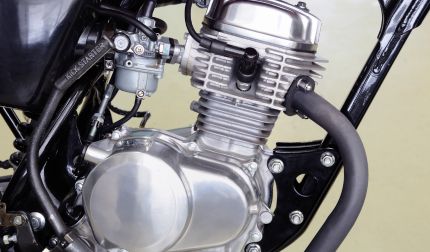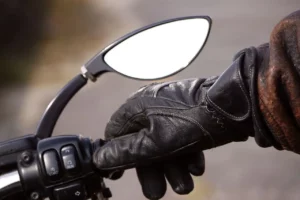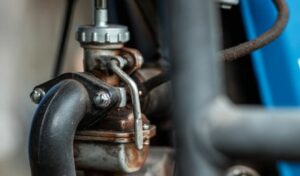The carburetor, though often overlooked, is one of the most vital parts of a motorcycle. Its role is essential for the smooth and efficient operation of the engine. It is the gateway through which the vital mix of air and fuel reaches the engine. A well-functioning carburetor ensures that this mix is just right, guaranteeing optimal engine performance and fuel efficiency. Thus, carburetor issues can affect motorcycle performance.
At its core, the carburetor is responsible for regulating the ratio of air and fuel that is burned in the engine. When you twist the throttle, the carburetor responds by sending a calculated amount of this air-fuel mixture into the combustion chamber of the engine. A good air-fuel mix powers the motorcycle.
The engine responds smoothly and powerfully when the carburetor delivers the right air and fuel. The motorcycle performs optimally, consuming fuel efficiently, and providing the desired acceleration and power.
However, when the carburetor is faulty or poorly adjusted, it may deliver too much or too little fuel, causing a variety of problems such as poor fuel economy, weak acceleration, or even engine damage. That’s why understanding the signs of a bad carburetor can save motorcycle riders time, money, and potential safety hazards on the road. This guide aims to solve this mystery.
What is a Carburetor?
A carburetor mechanically mixes petrol and air for the engine. The carburetor breaks fuel into tiny droplets and mixes it with the right amount of air to promote efficient combustion. Internal combustion engines, including many motorcycles’, have carburetors.
Air moves faster through a narrow passage, lowering pressure in a carburetor. The Venturi effect describes this. Air speeds up and pressure drops in the carburetor’s narrow Venturi. Fuel from the carburetor’s fuel bowl mixes with air due to low pressure.
Opening the throttle valve lets more air in, which adds fuel. The air-fuel mixture enters the combustion chamber and is ignited by the spark plug.
Components of a Carburetor
Venturi: The narrow carburetor venturi increases air speed and decreases pressure. Italian physicist Giovanni Battista Venturi discovered this fluid dynamic principle.
Throttle Valve: The throttle valve controls carburetor airflow via the handlebar throttle control. The throttle control opens the throttle valve, drawing more air and fuel into the engine.
Fuel Bowl: The Venturi draws fuel from the fuel bowl. To maintain supply, the fuel pump refills it.
Float: Controls fuel bowl level. When the fuel level rises high enough, the float closes a valve. Prevents fuel overflow.
Jets: Small openings draw fuel into the airstream. Motorcycle carburetors have main and idle jets. The main jet controls fuel flow at high speeds, while the idle jet controls it at idle. They determine engine performance and fuel efficiency.
Symptoms of a Bad Carburetor
1. Erratic or Poor Idle
One of the first signs of a problematic carburetor often involves the way the motorcycle idles. The idle speed is regulated by the idle jet and air-fuel mixture screw in the carburetor, so any irregularities here can directly point to a carburetor issue.
Rough Idling: Rough idling is often characterized by an inconsistent “rumble” or “shake” from the engine when the motorcycle is at rest and the engine is running. A dirty or clogged carburetor may cause the air-fuel mixture to be off.
Stalling at Idle: If your motorcycle tends to stall or die when you’re at a stop or when the throttle is not being applied, this is another potential symptom of a bad carburetor. Again, this could be due to an incorrect air-fuel mixture, a clogged idle jet, or perhaps the float level in the carburetor being set incorrectly.
Engine Revving without Throttle Input: If the engine speed increases even without any throttle input, it’s referred to as ‘idle surge’ or ‘hunting’. This is usually a sign of an air leak into the intake manifold or a carburetor running lean (too much air in the mixture). Both cases will disturb the air-fuel balance, causing irregular engine speeds.
2. Difficulty Starting the Motorcycle
Issues with the carburetor can also make starting the motorcycle a difficult task. These problems are often due to the improper ratio of air and fuel, leading to combustion inefficiency.
Hard Starting: A common symptom of a bad carburetor is a motorcycle that is hard to start, especially when it’s cold. Clogged carburetors may prevent the engine from receiving enough fuel. The choke, which enriches the fuel-air mixture, may also be improperly set or malfunctioning.
Frequent Choking Required: If you find that you frequently need to use the choke to start your motorcycle, even when it’s not cold, this could be another sign of a carburetor issue. This suggests that the carburetor is not delivering the right fuel-air mixture for the engine to start efficiently without the enrichment provided by the choke.
Engine Flooding: Conversely, if the carburetor allows too much fuel into the engine, it can lead to a condition known as flooding. Symptoms of a flooded engine may include a strong smell of gasoline, difficulty starting, and rough running once the engine does start. This may be due to a sticking float in the carburetor fuel bowl or a leaking or stuck open carburetor float needle.
3. Uneven or Poor Acceleration
A bad carburetor can also manifest through issues with the motorcycle’s acceleration. Improper air-fuel mixtures cause combustion inefficiencies.
Hesitation During Acceleration: A carburetor problem may cause a lag or hesitation when you twist the throttle. The carburetor might not be delivering the increased amount of fuel required for acceleration, causing the motorcycle to stutter or hesitate.
Flat Spots in Power Delivery: Flat spots refer to periods during acceleration when the power seems to ‘dip’ or ‘plateau’ before coming back again. This can often be traced back to an incorrectly adjusted carburetor. The transition from the idle jet to the main jet may not be smooth, leading to these flat spots in power delivery.
Bogging Down: Bogging down is when the motorcycle seems to lose power and struggle during acceleration. This usually happens when the carburetor is delivering too rich a mixture (too much fuel in relation to air) causing the engine to labor or ‘bog down’ under the excess fuel. This could be due to a clogged air filter, incorrect carburetor settings, or a malfunctioning carburetor component.
4. Decreased Fuel Efficiency
Bad carburetors reduce motorcycle fuel efficiency. The carburetor controls the air-fuel ratio, which optimises combustion and fuel economy.
Increased Fuel Consumption: A carburetor issue may cause your motorcycle to burn more gas. A rich carburetor (more fuel, less air) wastes fuel. This could be due to a variety of issues such as incorrect carburetor adjustment, a malfunctioning float causing an overflow of fuel, or a clogged air passage.
Increased fuel consumption means lower mileage. If you find yourself needing to refuel more frequently despite your riding habits remaining consistent, this could indicate a problem with the carburetor. A faulty carburetor’s incorrect air-fuel mixture causes poor mileage.
5. Engine Backfiring
Backfiring—a loud bang or explosion from the motorcycle’s exhaust or intake—can also be caused by a bad carburetor. Unburned fuel in the exhaust system is often caused by an improper air-fuel mixture.
Backfiring: Rich engine conditions cause backfiring (i.e., there is too much fuel compared to air in the mixture). Backfiring is caused by excess fuel igniting in the exhaust pipe rather than the combustion chamber. Clogged air filters, bad carburetors, and ignition timing issues cause backfiring.
Backfiring During Deceleration: Backfiring when you let off the throttle may indicate a carburetor that is “lean” (too much air, not enough fuel). Engine speed decreases when the throttle valve closes. The mixture can become lean and backfire if the carburetor’s idle circuit is not supplying enough fuel. An exhaust air leak could ignite unburned fuel.
6. Black Smoke from Exhaust
A faulty carburetor can cause black smoke from the motorcycle’s exhaust. Excessively rich engine air-fuel mixtures cause this.
Rich Fuel Mixture: A “rich” carburetor mixture has too much fuel and not enough air. In this case, the exhaust emits black smoke from unburned fuel. A faulty float, needle valve, or adjustment can allow too much fuel into the engine from a carburetor.
Rich fuel mixtures indicate an air-fuel ratio imbalance. 14.7 parts air to 1 part fuel is ideal for efficient combustion. A carburetor problem can disrupt this ratio, causing black smoke, poor fuel economy, and poor performance. Understanding this symptom can help detect a carburetor problem before it causes engine damage.
7. Overheating Issues
Motorcycle overheating issues can often be traced back to carburetor problems. Overheating is detrimental to the engine’s longevity and performance and should be addressed promptly.
Lean Fuel Mixture: A lean mixture – where there’s too much air compared to fuel – can cause the engine to overheat. This is because a lean air-fuel mixture burns hotter than the ideal ratio. If the carburetor is incorrectly adjusted or if there’s a problem like a clogged fuel jet, it could lead to a lean condition, causing the engine temperature to rise.
Carburetor Malfunction and Engine Heat: A malfunctioning carburetor that constantly delivers a lean mixture not only affects the motorcycle’s performance but also significantly increases engine heat. Continuous overheating can lead to severe engine damage, including warping of the engine parts or, in extreme cases, engine seizure. Recognizing this symptom early can help prevent costly engine repairs. Regular inspection and cleaning of the carburetor, along with correct adjustments, can ensure the optimal air-fuel mixture, promoting efficient combustion and preventing overheating.
8. Fouled Spark Plugs
Bad carburetors can cause spark plug fouling. Spark plugs reveal a lot about combustion and carburetor performance.
Fouled spark plugs can cause motorcycle misfires, poor acceleration, and lower fuel economy. Fouled spark plugs cannot ignite the air-fuel mixture in the combustion chamber, causing these performance issues.
Carburetor issues cause spark plug fouling. Spark plug fouling can result from a rich carburetor. Excess fuel deposits on the spark plug reduce its sparking ability. Unburned fuel can contaminate engine oil, causing further issues. Spark plug maintenance can detect carburetor issues before they cause engine damage.
9. Leaking Fuel
Carburetors that leak fuel are dangerous. Because petrol is flammable, they waste fuel and are dangerous.
Visible fuel leaks indicate carburetor issues. Carburetors and their hoses can leak fuel. A stuck or damaged float needle allows fuel to enter the carburetor bowl, causing an overflow. Worn gaskets or seals can also leak fuel from the carburetor assembly.
Fuel Odor and Safety Concerns: A strong petrol smell near the motorcycle can indicate a leak even if it is not visible. With a spark or high heat, fuel leaks can cause fires and explosions. Petrol fumes can also harm health. Thus, any suspected fuel leaks should be addressed immediately to protect the motorcycle and rider.
10. Rough or Unstable Engine Performance
Bad carburetors affect motorcycle engine performance. Incorrect air-fuel mixtures can cause engine instability and poor performance.
Surging or Hunting: The engine’s RPM fluctuates without throttle input. A clogged jet, air leak into the intake manifold, or improperly adjusted air-fuel mixture screw can cause a lean mixture (too much air and not enough fuel).
Uneven Power Delivery: Carburetor problems can cause power fluctuations at constant speed. The carburetor may be supplying inconsistent fuel, causing power fluctuations. The carburetor’s jets, floats, or other fuel-regulating parts may be at fault.
Loss of Power: A carburetor problem may cause power loss, especially when accelerating. The engine may struggle under load and feel weaker if the carburetor isn’t delivering enough fuel. Clogged fuel jets, stuck floats, and other carburetor issues may cause this. Regular carburetor maintenance and cleaning can prevent these issues and ensure your motorcycle delivers consistent power.
11. Difficulty Maintaining Consistent Speed
Motorcycle speed requires a good carburetor. Speed fluctuations and throttle response can result from carburetor problems.
Speed Fluctuations: A faulty carburetor may cause your motorcycle to fluctuate in speed, especially at cruising speed. Clogged jets or a carburetor float may disrupt fuel delivery. Despite throttle input, the motorcycle may accelerate and decelerate.
Inconsistent Throttle Response: The throttle response is the motorcycle’s acceleration time. Carburetor problems may cause slow response times. A poor air-fuel mixture, clogged jet, or stuck throttle slide can slow throttle response. Regular carburetor service and adjustments can help maintain speed and throttle response for a smoother ride.
12. Engine Misfire
Carburetors can cause engine misfires, which sound like stumbling or stuttering. Misfires can damage performance if not addressed immediately.
Misfires can be caused by ignition, fuel, or air intake system issues. An incorrect air-fuel mixture may cause a carburetor misfire. Lean and rich conditions can misfire. Lean mixtures may not provide enough fuel for proper combustion, while rich mixtures may flood the engine and cause incomplete combustion.
Carburetor Misfire: Engine misfires related to the carburetor often cause poor acceleration, starting, and fuel efficiency. Unburned fuel may smell odd. To avoid engine damage, check and service the carburetor if the motorcycle shows these symptoms.
13. Strange Engine Noises
Bad carburetors can cause motorcycle engine noises. To avoid damage, investigate any unusual sounds.
Whistling or Hissing Sounds: Vacuum leaks often cause carburetor whistling or hissing. Extra air in the intake manifold disrupts the air-fuel balance and causes lean conditions. A gasket, cracked carburetor housing, or loose fittings may cause the leak. Vacuum leaks can damage engines, so such noises should be addressed immediately.
Popping or Spitting Noises: A lean mixture caused by carburetor issues may cause your motorcycle’s engine to pop or spit during deceleration. Clogged jets, needle valves, or air-fuel mixture settings may cause this. These sounds indicate multiple fuel detonations in the combustion chamber rather than a single controlled explosion. If ignored, pre-ignition or detonation can damage the engine.
14. Foul Odor from Exhaust
Your motorcycle’s exhaust smell can indicate engine and carburetor health. Carburetor issues can cause a foul smell.
Rich Fuel Smell: Your carburetor may be delivering a rich mixture if your exhaust smells like petrol. Unburned petrol is expelled through the exhaust because the engine receives more fuel than air. A stuck float, faulty jet, or carburetor adjustment can cause this.
As mentioned, a rich fuel mixture can cause unburned fuel to enter the exhaust system. This wastes fuel and can cause black smoke, exhaust system damage, and a foul odour. Fixing this issue quickly will improve fuel economy and prevent engine or exhaust system damage.
15. Poor Performance at High Altitudes
Due to air density changes, altitude can significantly impact motorcycle performance. Unadjusted carburetors for high altitudes can cause performance issues.
Altitude Carburetor Adjustments: Air density decreases with altitude. Air has fewer oxygen molecules. At higher altitudes, the carburetor must deliver less fuel to maintain the correct air-fuel mixture. Adjusting the carburetor’s jet sizes or needle position can do this. Modern carburetors may have altitude compensation.
High-Altitude Carburetor Tuning Problems: The carburetor can supply the same amount of fuel at high altitude if it’s not adjusted. Less oxygen for combustion creates a rich mixture. This can cause poor acceleration, fuel efficiency, a rough or unstable idle, black exhaust smoke, and engine starting issues. These symptoms are similar to a bad carburetor at sea level, emphasising the importance of carburetor adjustment at higher altitudes.
16. Vibrations or Shaking
Carburetor issues can cause motorcycle vibrations. Vibrations can result from uneven fuel delivery to the cylinders or air-fuel mixture.
Carburetor-Induced Engine Vibrations: The carburetor may cause engine vibrations. The engine may run unevenly if the carburetor doesn’t supply a consistent air-fuel mixture to each cylinder. In multi-cylinder motorcycles, each cylinder has its own carburetor. The engine may shake or vibrate due to uneven running.
Balancing Issues: Your motorcycle may vibrate or shake if its carburetors aren’t balanced. Out-of-balance carburetors supply different air-fuel mixtures to each cylinder. This uneven power output shakes the engine. Balanced carburetors open and close at the same time and supply the same air-fuel mixture. If you’re unsure, leave this process to a professional.
Conclusion
Recognizing and fixing carburetor problems is essential for motorcycle performance, safety, and longevity. Paying attention to your motorcycle’s behaviour can help detect carburetor issues early, preventing engine and component damage. Recognizing symptoms like trouble starting, poor performance, or strange noises lets you act quickly.
Check and clean the carburetor’s jets and float mechanism if you suspect a problem. Adjusting the air-fuel mixture and balancing multiple carburetors may be needed. In severe cases, a full rebuild or replacement may be needed.
Some carburetor maintenance tasks can be done by experienced DIYers, but others may require a professional. In particular, carburetor tuning and balancing may require specialised tools and knowledge. If you’re unsure, ask a mechanic for help.
Cleaning and adjusting your carburetor regularly ensures its performance and longevity. A well-maintained carburetor delivers the right air-fuel mixture for smoother operation, better fuel efficiency, and longer engine life. For maintenance schedules and procedures, consult your motorcycle’s owner’s manual.
Carburetors need regular maintenance. Staying alert to carburetor problems and fixing them quickly can make riding more reliable and enjoyable.






